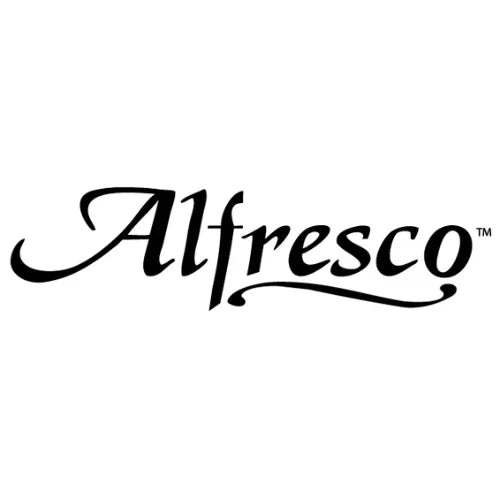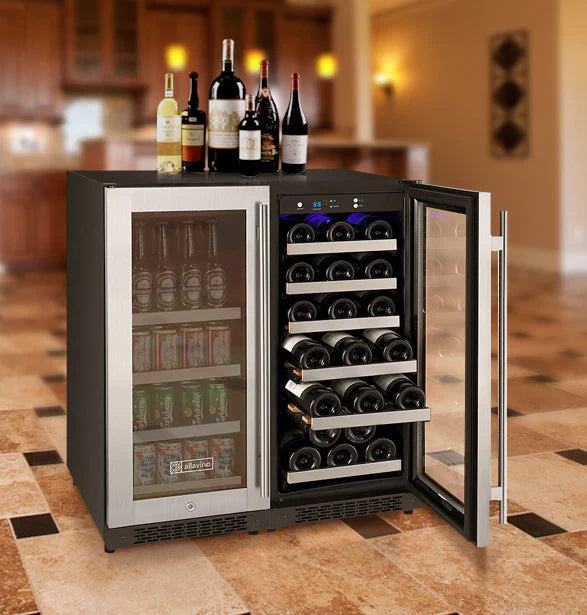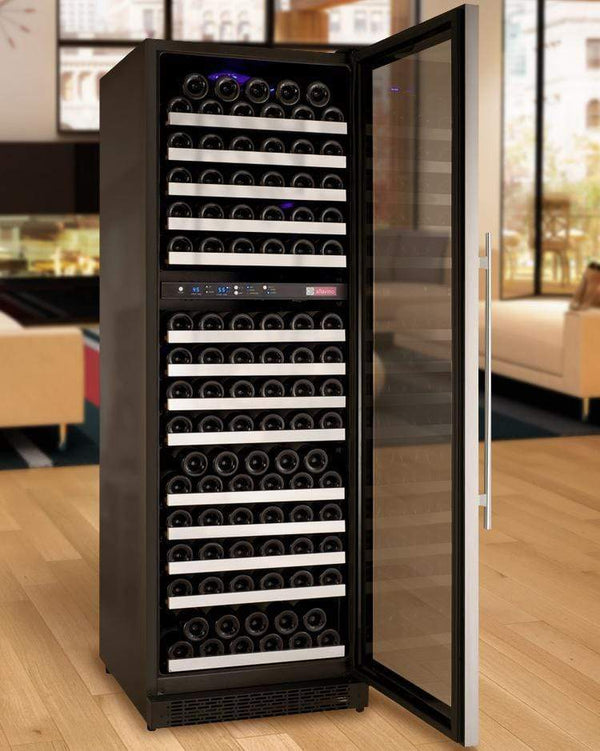Designing a Wine Cellar?
Let’s get it right.
Our specialists review your room layout, insulation, and heat load to recommend the correct cooling system for stable temperature and reliable climate control.
Wine Closet Cooling Units: The Ultimate Guide to Proper Wine Storage
Introduction: Essential Guide for Preserving and Aging Your Wine Collection
By Jim Hopper, Wine Cooling Expert
Wine is a living, evolving beverage, and how you store it directly impacts its flavor, aroma, and value. A wine closet cooling unit is essential for anyone serious about preserving and aging wine. In this guide, you’ll learn what these units are, why they matter, how to choose the right one, and how to ensure your collection remains in perfect condition.
For a comprehensive overview of all cooling options, check out our Ultimate Guide to Wine Cellar Cooling Systems.
What Is a Wine Closet Cooling Unit?

A wine closet cooling unit is a specialized appliance designed to control the temperature and humidity inside a wine closet or compact wine cellar. Unlike regular air conditioners, these units are engineered to maintain the steady, cool, and slightly humid environment that wine demands for proper aging. They help prevent spoilage, preserve cork integrity, and allow your wine to develop its best qualities over time.
What’s a wine closet?
A wine closet is a dedicated, insulated space—often a converted closet or small room—used for wine storage. It’s ideal for collectors with limited space who still want to store their bottles in optimal conditions. For more ideas, see our tips for cooling units in small wine cellars.
Why Proper Temperature and Humidity Matter
Wine is highly sensitive to its environment. Fluctuating temperatures can cause wine to expand and contract, pushing corks out or drawing air in, leading to oxidation and spoilage. Low humidity dries out corks, while excess moisture can cause mold. The ideal storage conditions are:
- Temperature: 55-57°F (12-14°C)
- Humidity: Around 60%
Maintaining these parameters ensures your wine ages gracefully, preserving its intended flavors and aromas. For more, read about ideal wine cellar temperature.
Important:
Never use a standard air conditioner in your wine closet. Regular AC units cannot maintain the precise temperature and humidity wine needs, risking spoilage and oxidation.
Key Components and Functions of Wine Closet Cooling Units
-
Cooling Capacity:
The unit’s power should match your closet’s size. An undersized unit won’t cool effectively; an oversized one may cycle too quickly, impacting humidity control. -
Humidity Control:
Proper humidity keeps corks moist and prevents oxidation. Some units add or remove moisture as needed. -
Temperature Regulation:
Advanced thermostats allow precise temperature settings, so you can cater to different wine types or aging preferences. -
Airflow and Ventilation:
Good airflow prevents hot spots and ensures even cooling. Ensure the unit has proper clearance and that exhaust vents aren’t blocked.
Types of Wine Closet Cooling Units
There are several types of wine closet cooling units, each with unique benefits and installation requirements:

-
Through-the-Wall Units:
These compact units are installed directly into a wall and are ideal for small wine closets. For example, the WhisperKOOL SC PRO 2000 and CellarPro 1800QT are popular choices.

-
Split Systems:
These separate the noisy and heat-producing components from the indoor unit, reducing noise and offering flexible installation. The WhisperKOOL Slimline LS is a low-profile, wall-mounted solution.

-
Self-Contained Systems:
All components are combined in one unit, making installation straightforward. The Wine Guardian D025 is a reliable example for closet-sized cellars.
You can also browse our full selection of wine cellar cooling units for more options.
Popular Brands and Models
When choosing a wine closet cooling unit, it helps to know what’s available. Leading brands include:
- WhisperKOOL: Known for innovation, quiet operation, and a range of models for different cellar sizes.
- CellarPro: Offers advanced features, energy efficiency, and dependable performance.
- Breezaire: Trusted for reliability and ease of installation in small spaces.
- Wine Guardian: Flexible, high-quality self-contained and ducted options.
Sizing Your Wine Closet Cooling Unit
Selecting the right size is crucial for efficient operation. To estimate the required cooling capacity:
- Measure your closet’s volume:
Length × Width × Height (in feet) = Cubic Feet - Consider insulation quality, door type (glass doors may need more power), and any external heat sources.
- For step-by-step help, use our wine cellar cooling unit sizing guide.
If in doubt, reach out to the manufacturer or a cellar design expert for advice.
Accessories and Customization Options

Enhance your wine closet cooling system with these popular accessories:
- Digital Controllers: For precise temperature and humidity adjustments.
- Remote Monitoring: Wi-Fi modules and alarms to notify you of temperature changes.
- Humidity Monitors: Ensure optimal humidity is maintained.
- Bottle Probes: Measure the actual temperature inside a wine bottle for ultimate accuracy.
Factors to Consider When Choosing a Wine Closet Cooling Unit
-
Cellar Size and Configuration:
Measure your wine closet’s cubic footage to determine the right cooling capacity. Odd shapes or glass doors may require more powerful units. -
Insulation:
Well-insulated walls, doors, and ceilings help maintain a stable environment and reduce the workload on your cooling unit. -
Noise Level:
If your wine closet is near living spaces, opt for quieter models or split systems. -
Energy Efficiency:
Energy-efficient units lower electricity costs and are better for the environment. -
Maintenance Requirements:
Choose a unit that’s easy to clean and service. Check for accessible filters and clear instructions. -
Budget:
Cooling units vary in price. While it’s tempting to choose the cheapest option, investing in a reliable, efficient unit pays off in long-term wine preservation and lower maintenance.
Professional Support and Design Services
For complex installations or custom wine closets, consider consulting a professional. Many manufacturers and retailers offer expert design services to help you plan your space and select the right unit. Professional advice can prevent costly mistakes and ensure your collection is protected from day one.
Installation and Maintenance
Professional Installation:
While some through-the-wall units are DIY-friendly, professional installation is recommended for split and ducted systems. Proper setup ensures efficient operation and prevents costly mistakes. For a step-by-step overview, see our installation guide.
Regular Maintenance:
- Clean or replace filters regularly.
- Check for leaks or unusual noises.
- Inspect seals and insulation.
- Schedule annual professional servicing if possible.
Routine care extends the life of your unit and ensures your wine stays protected.
Conclusion

A wine closet cooling unit is a smart investment for anyone who wants to protect and age their wine collection properly. By choosing the right unit, ensuring proper installation, and keeping up with maintenance, you’ll create the perfect environment for your bottles to mature and shine.
Need help choosing the perfect wine closet cooling unit for your space?
Contact the experts at Wine Coolers Empire for personalized recommendations and support.
Call Us: 1-888-407-7770
Email: support@winecoolersempire.com
📚 Frequently Asked Questions (FAQs)
Can I use a regular air conditioner in my wine closet?
How do I size a cooling unit for my closet?
How loud are wine closet cooling units?
What’s the ideal temperature and humidity for wine?
Can I store other items in my wine closet?

Designing or Upgrading a Wine Cellar?
We got you! Here at Wine Coolers Empire, we will guide you in building your dream wine cellar.











